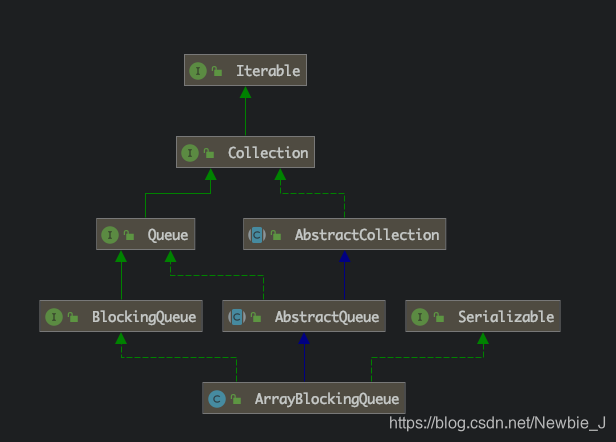JAVA并发容器之ArrayBlockingQueue源码解析
<JDK1.8/JDK8>

1、主要成员变量
/** 数组实现的存储结构 */
final Object[] items;
/** 下一个 take, poll, peek or remove 操作的下标*/
int takeIndex;
/** 下一个 put, offer, or add 操作的下标 */
int putIndex;
/** 存储的元素个数 */
int count;
/*
* Concurrency control uses the classic two-condition algorithm
* found in any textbook.
*/
/** 队列的可重入锁 */
final ReentrantLock lock;
/** take操作等待的Condition */
private final Condition notEmpty;
/** put操作等待的Condition */
private final Condition notFull;
2、构造方法
/**
* 指定队列容量,
* false,为默认非公平实现
*/
public ArrayBlockingQueue(int capacity) {
this(capacity, false);
}
/**
* 通过指定fair参数实现公平队列
*/
public ArrayBlockingQueue(int capacity, boolean fair) {
if (capacity <= 0)
throw new IllegalArgumentException();
this.items = new Object[capacity]; // 初始化数组对象来实际存储数据
lock = new ReentrantLock(fair); // 初始化锁
notEmpty = lock.newCondition(); // 初始化两个Condition
notFull = lock.newCondition();
}
/**
* 使用实现Collection接口的对象初始化队列
*/
public ArrayBlockingQueue(int capacity, boolean fair,
Collection<? extends E> c) {
this(capacity, fair);
final ReentrantLock lock = this.lock;
lock.lock(); // Lock only for visibility, not mutual exclusion
try {
int i = 0;
try {
for (E e : c) {
checkNotNull(e);
items[i++] = e;
}
} catch (ArrayIndexOutOfBoundsException ex) {
throw new IllegalArgumentException();
}
count = i;
putIndex = (i == capacity) ? 0 : i;
} finally {
lock.unlock();
}
}
2、有关阻塞的实现方法
/**
* Inserts the specified element at the tail of this queue, waiting
* for space to become available if the queue is full.
*
* @throws InterruptedException {@inheritDoc}
* @throws NullPointerException {@inheritDoc}
*/
public void put(E e) throws InterruptedException {
checkNotNull(e);
final ReentrantLock lock = this.lock;
lock.lockInterruptibly();
try {
while (count == items.length)
notFull.await(); // 队列满,当前生产者线程阻塞在notFull
enqueue(e); // 否则插入数据
} finally {
lock.unlock();
}
}
/**
* Inserts element at current put position, advances, and signals.
* Call only when holding lock.
*/
private void enqueue(E x) {
// assert lock.getHoldCount() == 1;
// assert items[putIndex] == null;
final Object[] items = this.items;
items[putIndex] = x;
if (++putIndex == items.length)
putIndex = 0;
count++;
notEmpty.signal(); // 通知在notEmpty阻塞着的消费者线程有数据可取
}
重点为第14、33行。
public E take() throws InterruptedException {
final ReentrantLock lock = this.lock;
lock.lockInterruptibly();
try {
while (count == 0)
notEmpty.await(); // 当前消费者线程阻塞在notEmpty
return dequeue(); // 否则删除数据
} finally {
lock.unlock();
}
}
/**
* Extracts element at current take position, advances, and signals.
* Call only when holding lock.
*/
private E dequeue() {
// assert lock.getHoldCount() == 1;
// assert items[takeIndex] != null;
final Object[] items = this.items;
@SuppressWarnings("unchecked")
E x = (E) items[takeIndex];
items[takeIndex] = null;
if (++takeIndex == items.length)
takeIndex = 0;
count--;
if (itrs != null)
itrs.elementDequeued();
notFull.signal(); // 通知在notNull阻塞着的生产者线程队列不满,可以插入数据
return x;
}
3、await方法
/**
* Implements interruptible condition wait.
* <ol>
* <li> If current thread is interrupted, throw InterruptedException.
* <li> Save lock state returned by {@link #getState}.
* <li> Invoke {@link #release} with saved state as argument,
* throwing IllegalMonitorStateException if it fails.
* <li> Block until signalled or interrupted.
* <li> Reacquire by invoking specialized version of
* {@link #acquire} with saved state as argument.
* <li> If interrupted while blocked in step 4, throw InterruptedException.
* </ol>
*/
public final void await() throws InterruptedException {
if (Thread.interrupted())
throw new InterruptedException();
Node node = addConditionWaiter();
long savedState = fullyRelease(node);
int interruptMode = 0;
while (!isOnSyncQueue(node)) {
LockSupport.park(this);
if ((interruptMode = checkInterruptWhileWaiting(node)) != 0)
break;
}
if (acquireQueued(node, savedState) && interruptMode != THROW_IE)
interruptMode = REINTERRUPT;
if (node.nextWaiter != null) // clean up if cancelled
unlinkCancelledWaiters();
if (interruptMode != 0)
reportInterruptAfterWait(interruptMode);
}
主要是第21行,调用LockSupport.park(this)来阻塞当前线程。
进一步查看该方法:
public static void park(Object blocker) {
Thread t = Thread.currentThread();
setBlocker(t, blocker);
UNSAFE.park(false, 0L);
setBlocker(t, null);
}
先调用setBlocker方法保存要阻塞的线程,然后调用UNSAFE.park阻塞。
